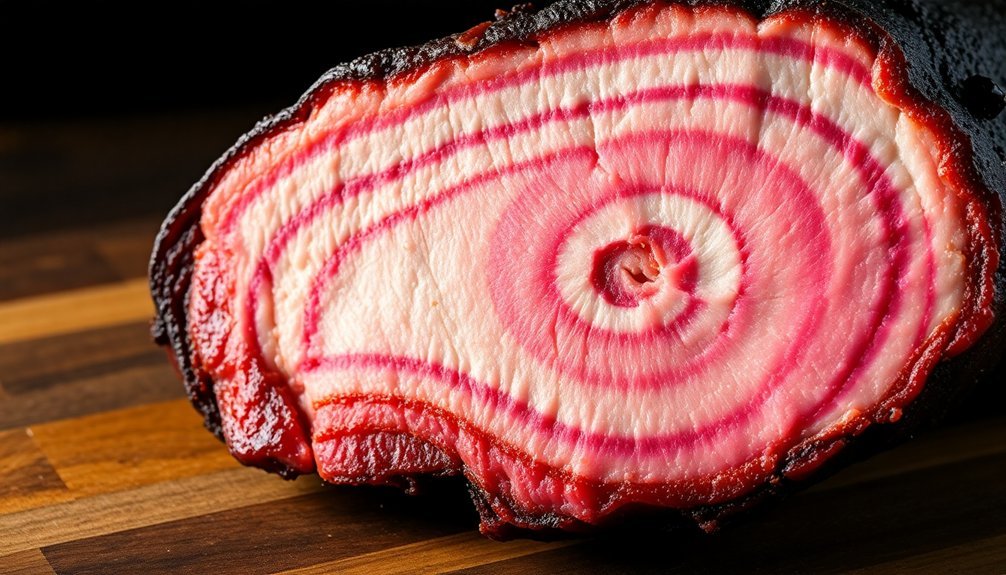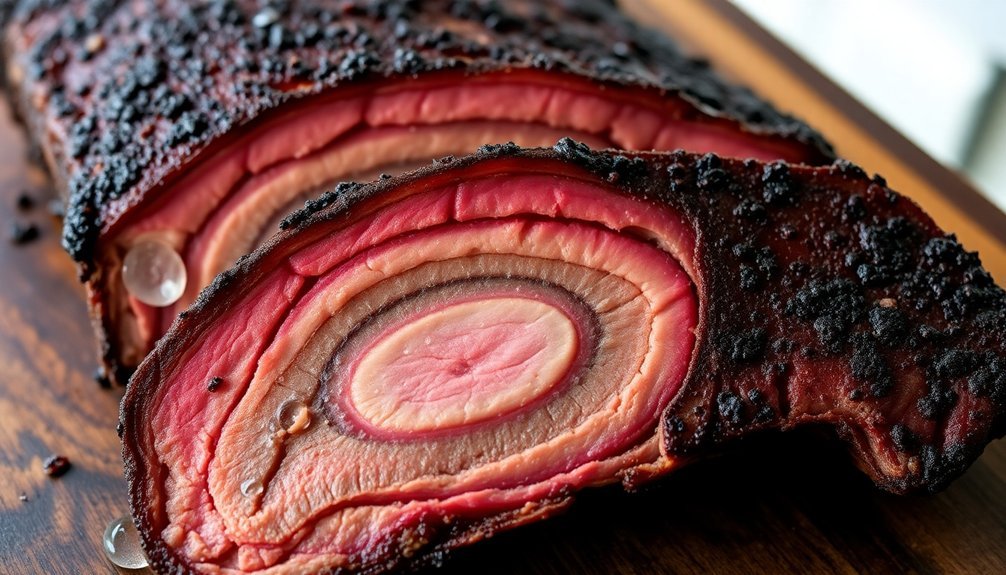You'll create perfect smoke rings in your barbecue through three key processes. First, chemicals in wood smoke, specifically nitric oxide and carbon monoxide, react with myoglobin proteins in your meat's muscle tissue. Second, maintaining consistent temperatures between 225°F and 250°F allows ideal gas penetration and chemical reactions to occur. Third, proper surface moisture helps these reactions take place, so using a water pan and occasional spritzing enhances ring development. While these basics will get you started, mastering the nuances of wood selection, airflow control, and meat preparation will elevate your smoking game to competition level.
Chemical Reactions in Muscle Tissue

The remarkable pink band known as the smoke ring forms through an intricate dance between meat proteins and smoke compounds. At the heart of this process is myoglobin, a protein in your meat's muscle cells that contains iron and typically gives raw meat its red color.
When you smoke meat, two essential gases – nitric oxide (NO) and carbon monoxide (CO) – penetrate the surface and interact with myoglobin's iron components.
You'll get the best results when smoking beef since it contains the highest concentration of myoglobin, followed by pork and chicken. These gases can only reach about an eighth of an inch into your meat, which explains why smoke rings don't extend deeper. Smoke temperatures between 225°F and 250°F produce optimal smoke ring development.
The interaction between NO, CO, and myoglobin's iron keeps the meat pink by preventing oxidation, but this process stops when your meat reaches about 170°F, as the myoglobin breaks down at this temperature.
If you're aiming for a pronounced smoke ring, you'll want to start with cold meat and trim excess fat, as this allows better gas penetration. The meat's age and freshness also matter – fresher cuts and meat from older animals contain more myoglobin, potentially creating more prominent rings.
Wood Selection and Heat Control
During your smoking journey, selecting the right wood and maintaining proper heat control will greatly impact your meat's final flavor and texture.
You'll want to focus on hardwoods like oak, hickory, maple, and pecan, as they provide the best smoking results. Oak works exceptionally well for brisket and ribs, while hickory's sweet, savory profile suits pork and chicken perfectly. Premium BBQ fuels are worth the investment for optimal results. For seafood, you'll find alder's subtle smoke ideal, and fruit woods like apple and cherry offer a lighter touch for poultry and game.
Your wood form choice matters considerably. While logs and chunks provide longer-lasting smoke for traditional BBQ, chips work better for shorter cooks, and pellets offer consistency in pellet grills.
You'll need to maintain temperatures between 225°F and 250°F for the best smoke ring development. Keep your heat low and consistent to prevent the meat's outer layer from cooking too quickly.
Remember to avoid softwoods like pine and cedar – their resins create bitter flavors. Instead, you might try combining different hardwoods for unique flavor profiles.
Proper airflow control prevents flare-ups and guarantees steady smoking conditions throughout your cook.
Surface Preparation and Moisture

Now that you've mastered wood selection, proper surface preparation and moisture control will determine your smoke ring's success.
You'll need to maintain consistent surface moisture throughout the smoking process, as it's essential for the chemical reaction between nitrogen oxide, carbon monoxide, and myoglobin that creates that coveted pink ring. Maintaining a constant 250° F in your smoker provides ideal conditions for smoke ring formation.
Start by scoring your meat to release natural juices, then apply a thin layer of oil to seal in moisture.
While you'll want to pat the surface dry before applying your rub, don't skip using a water pan in your smoker to maintain humidity. You can enhance your results by incorporating ground celery seed in your rub or using curing agents like sodium nitrite.
During smoking, you'll need to monitor and adjust moisture levels regularly. Use light spraying or mopping techniques, but don't start too early as you'll risk washing away your seasonings.
When you hit the stall phase, consider wrapping your meat in butcher paper or foil – this helps retain moisture while still allowing smoke penetration.
Keep your smoker's humidity levels high, as this supports continuous smoke ring development even at higher temperatures.
Frequently Asked Questions
Can I Achieve a Smoke Ring When Using an Electric Smoker?
Yes, you can achieve a smoke ring in an electric smoker. Use cold meat, wet wood chips, maintain high humidity, and smoke at lower temperatures. It'll be more challenging than traditional smokers but still possible.
Does the Color of the Smoke Ring Indicate Meat Doneness?
No, the smoke ring's color doesn't indicate your meat's doneness. It's just a chemical reaction between smoke's nitrogen dioxide and the meat's myoglobin, creating a pink ring that's purely aesthetic. Always use a thermometer.
Will Pre-Brining Affect the Development of a Smoke Ring?
You'll find that pre-brining can actually enhance your smoke ring development. While the added moisture helps absorb smoke compounds, just make certain your meat's surface isn't too wet before smoking to achieve the best results.
Can I Get Smoke Rings on Fish or Seafood?
You'll find it very difficult to get smoke rings on fish or seafood due to their low myoglobin content. While you can smoke them for flavor, they won't develop the characteristic pink ring like red meats.
Does Altitude Affect Smoke Ring Formation During Barbecuing?
While altitude can affect your overall barbecuing process, there's no direct evidence that it impacts smoke ring formation. You'll still need to focus on temperature, moisture, and proper smoke production for the best results.
In Summary
You'll find achieving perfect smoke rings isn't as mysterious as it seems. By understanding the chemical reactions between myoglobin and nitric oxide, choosing the right wood for consistent heat, and properly preparing your meat's surface moisture, you're well on your way to mastering this craft. Remember, patience and attention to these three critical factors will help you create those coveted pink rings every time.





Leave a Reply